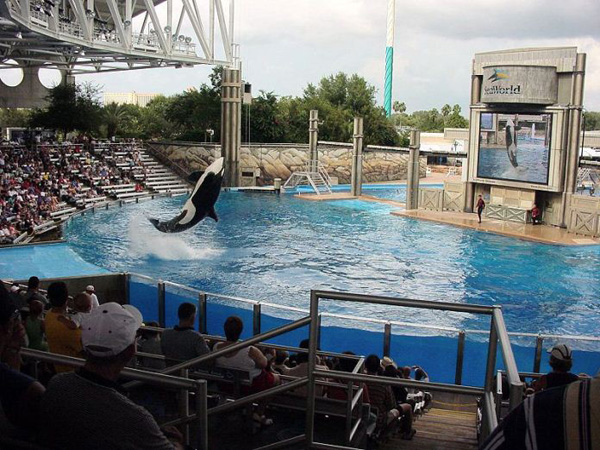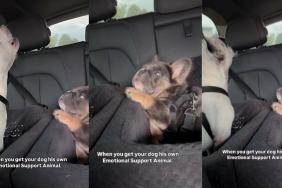by Michael Mountain
Founder, Best Friends Animal Society, Zoe, and The Stubby Dog Project
There’s something slightly macabre about Tilikum going back on show at SeaWorld Orlando.
It’s just more than a year since the killer whale dragged his trainer, Dawn Brancheau, to the bottom of the pool and killed her. She was his third victim. So, as Tilikum makes his re-appearance this week, it’s inevitably going to be a bit like watching some celebrity performer who’s just been released from prison … and you can’t help but be riveted by the possibility that he’s going to do it again.
Few go to resorts like Orlando without a video camera in their pocket. And while it used to be somewhat easier for marine circuses and other animal businesses to keep deaths, injuries and other mishaps out of the spotlight, those days are long gone.
So SeaWorld is making every effort to ensure that there are no more life-threatening mishaps. It’s even built a special floor elevator so that if Tilikum or any of the other whales grabs a trainer and drags them down to the bottom of the pool, workers there can lift whale and trainer to the surface, grab the victim and rush him or her to emergency care. That, of course, may also have the unwanted effect of enabling the audience to see yet more of any such gruesome spectacle.
Altogether, it’s becoming harder and harder to keep information from going viral. Last year, cameras captured the moments just before Tilikum dragged Brancheau under the water. In a few weeks, on April 25, SeaWorld will be in court contesting a fine of $75,000, levied by the U.S. government’s Occupational Safety and Health Administration for placing profit above employee safety. The company is pressing for the hearing to be held behind closed doors, for no public discussion of the case, and for all documentation and evidence describing the conditions in which the orcas are kept in captivity to be kept under wraps. (Note to companies trying to keep things hidden: Remember WikiLeaks.)
SeaWorld is just one of many companies trying to keep the general public in the dark. In Iowa, the factory farm lobby has been trying to persuade the state legislature to make it a criminal offense for undercover investigators to capture video of animals being abused at factory farms. Commentators have been saying that such a law, even if passed, will probably be struck down in the courts as unconstitutional. But the attempt reveals just how worried those who abuse animals are becoming as they make ever more desperate efforts to stop us from seeing the horrors that go on at their facilities.
In the larger scheme of things, this is all part of a fundamental change that’s taking shape in our globalized society. Call it a grassroots revolution and the birth of a time when little can escape the eye of the camera. It’s almost the opposite of what George Orwell imagined 60 years ago in his novel 1984. In Orwell’s vision of the future, the one, single, all-seeing eye is that of the dictatorship. Today, however, that picture is increasingly being reversed and turned inside-out as the secret worlds of dictators, abusers and special interests are revealed by the all-seeing eye of the grassroots public.
This new kind of revolution is also affecting the way animal protection groups go about their business. There was a time, only a few years ago, when many groups felt they had to engage in radical and often illegal activities to fight cruelty to animals. But in an age when almost everyone has a camera in their pocket, we all become reporters. And people who mistreat animals find themselves in full retreat, not just from a few activists, but from the glare of a new media that’s made up of all of us.
In the same way as cellphone cameras and Twitter feeds have been playing such a key role in the downfall of repressive, abusive regimes across the Middle East, so have the cameras of ordinary people been key to what’s becoming a new era in animal protection.
It was the audience at SeaWorld that showed us the shocking truth of what happened when a stressed-out killer whale got angry and became lethal.
It’s been the hidden cameras of brave volunteers taking us inside the secret world of factory farms as their owners struggle to shrink back into the darkness like vampires hiding from the daylight.
It was video cameras in the audience in Ukraine that captured the moment when lions suddenly turned on their whip-wielding trainers and sent everyone fleeing in chaos and terror.
And this week, millions of us have been brought together in outrage after seeing the harrowing photos of Patrick the dog, who was starved to within hours of his life and then thrown down the garbage chute in a plastic bag.
Wherever they occur, and in whatever form, repression and abuse hate the spotlight. And the ever-present eye of the new grassroots media is now helping more and more people come together to raise their voices against cruelty to animals.
This article first appeared here on zoenature.org.
Michael Mountain is one of the founders of Best Friends Animal Society, the nation’s largest animal sanctuary and one of the pioneers of the no-kill movement for homeless pets. As president of Best Friends and editor of Best Friends magazine, he helped to build grassroots adoption and spay/neuter programs all over the country before stepping down in 2008. He currently is the editor and co-founder of Zoe— a new online magazine for people who care about animals, nature and the environment — and the co-founder of StubbyDog, which is working to change public perceptions of Pit Bulls.









